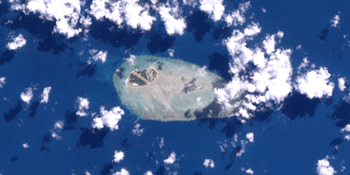Sue Islet (Queensland) facts for kids

Satellite image
|
|
| Administration | |
|---|---|
| State | Queensland |
Sue Island is a small island in the Torres Strait, which is a body of water between Australia and Papua New Guinea. It's also known as Warraber. Sue Island is the middle island of a group called The Three Sisters. It's part of Queensland, Australia, and is one of the many Torres Strait Islands.
Contents
Island Geography and Nature
Sue Island is located in the Vigilant Channel. It is a coral cay, which means it's a low-lying island made from coral and sand. The island has lots of traditional foods like wongai fruit and coconuts. The warm waters and coral reefs around the island are home to fish, turtles, and dugongs.
Rising Sea Levels
Like many islands, Sue Island is facing a challenge from rising sea levels. To protect the island, people have built special defenses along many of the beaches. Experts from the Intergovernmental Panel on Climate Change (IPCC) predict that by the year 2100, tides could rise by 30 to 110 centimeters. This depends on how much the world reduces carbon emissions.
Island History
The Warraber Island State School first opened its doors on January 29, 1985. Later, on January 1, 2007, it became known as the Warraber Island campus of the Tagai State College.
The People of Sue Island
The people living on Sue Island are part of the Kulkalaig group. This group also includes people from Nagi and other Central Islands of the Torres Strait. The Nagilgal and Waraberalgal people are actually the same group. Life on the island is very traditional. Important parts of their daily life include hunting, dancing, and thayilai (which are special feasts).
Languages Spoken
The language used every day on Warraber is Brokan, also known as Torres Strait Creole. However, the traditional language of the Waraber people is Kulkalgau Ya. This is one of the four dialects of Kalaw Lagaw Ya.
Here are some phrases in Kulkalagau Ya:
- Ni midhadh? means How are you?
- Ninu nel nga? means What is your name?
- Stuwa unaga? means Where is the store?
- Ninu waru ubilaig, au? means Do you like turtle?
- Ni kulkalgadh yamuleka, au? means Do you speak Kulkalgau Ya?
- Ni markaidh muleka, au? means Do you speak English?
- Ina ngau mudh. means This is my house.
- Kayib mina kapu goeiga. means This is a really nice day.
- Maal kapu idi. means The sea is dead calm.
- Inabi ai mina kapu mithalnga. means This food is very delicious.
- Aye, ngoeba buthuka. means Come, let's go to the beach.
Island Religion
Many people on Sue Island still have strong connections to their traditional religion. This religion often focuses on respecting ancestors and has a special system called a totemic clan structure. An important religious figure was Kulka, who was one of Malo-Bomai's brothers. The people of the island, called Kulkalgal, are named after Kulka.
Coming of the Light
Every year on July 1, the people of Sue Island celebrate the "Coming of the Light". This day remembers when a Christian reverend named Samuel MacFarlane arrived in 1871. He was from the London Missionary Society and came to share Christianity with the Indigenous people of the Torres Strait. Today, there are two main churches on the island: the more traditional Church of the Torres Strait and the Pentecostal Assemblies of God Church.
Education and Facilities
The Warraber Island Campus is a primary school for children from Early Childhood to Grade 6. It is part of the Tagai State College.
Sue Island also has an Indigenous Knowledge Centre. This center is run by the Torres Strait Island Regional Council. It works as both a library and a visitor center for the community.
The island is also home to modern technology that helps ships navigate. This includes systems like Automatic Identification Systems (AIS) and ship polling through the INMARSAT C satellite system. These tools help track ships and improve communication at sea.

